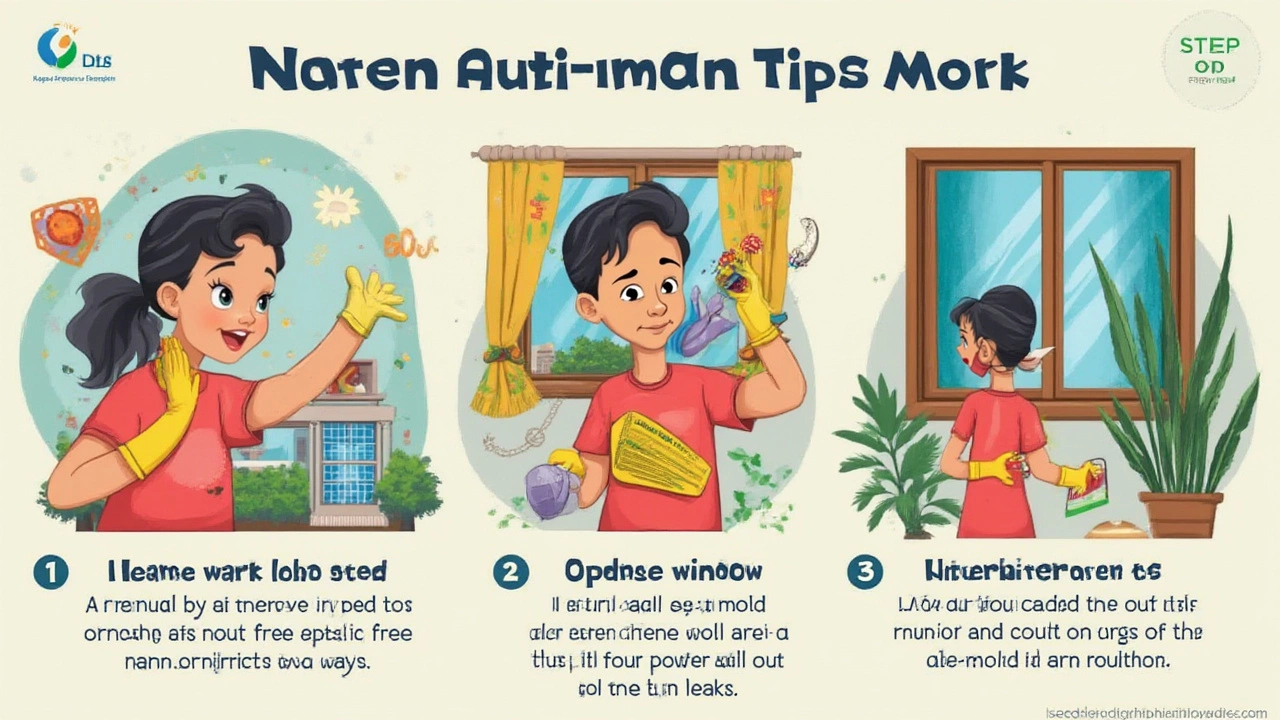Can You Get Sick from Mold in Buildings? Health Risks, Symptoms, and Solutions
Mold isn’t rare in the UK, especially if you’ve ever spent time living in Manchester or anywhere that deals with a proper rainy season. That musty smell creeping in from the corner of your living room? It’s not just annoying; it’s a red flag that your health might be in for a surprise. Believe it or not, damp and mold can make people feel absolutely miserable, and sometimes it sneaks up on you so slowly you don’t put two and two together.
Startling fact: One in five UK homes is estimated to have some sort of mold issue, according to a report by the English Housing Survey. Most people shrug it off as a cosmetic problem, but the effects can run much deeper. You’d never imagine a patch in your bathroom could be behind your dodgy cough or relentless tiredness, right?
Here’s the simple answer: Yes, you can get sick from mold in a building. But as with most things, there’s more to the story.
What Exactly Is Mold and Why Does It Grow Indoors?
Mold is essentially a type of fungus. You know how bread goes fuzzy if you leave it out too long? That’s mold. In buildings, it thrives best wherever it finds the holy trinity: moisture, warmth, and organic material. Plaster, wallpaper, carpet, wood – mold loves this stuff when it gets even slightly damp. Maybe there’s a drip you haven’t spotted behind your washing machine. Or those windows you forget to wipe after a hot shower? Prime mold territory.
Here’s what happens: mold releases tiny particles called spores into the air, which you can’t see. These spores travel easily, settling wherever they land. If the next spot is also a little humid, the cycle continues. That patch behind the wardrobe isn’t staying put — it could be headed to your kitchen next.
This isn’t just a UK thing, by the way. The World Health Organisation estimates that up to 50% of homes worldwide show visible signs of damp, and around 15-20% of buildings have actual health-relevant mold growth. That’s a lot of families dealing with invisible threats.
Why does mold turn up so much in Manchester, for example? Simple—wet weather, less sunlight, and older housing stock with built-in issues like poor ventilation and leaky roofs. When buildings trap in moisture, they’re practically rolling out the welcome mat for mold.
Some UK cities, especially Manchester, see rainfall nearly 150 days out of the year, making it one of the dampest regions. That’s not to mention heating bills driving people to block vents or keep windows closed, packing in all that extra steam from cooking, laundry, and hot showers.
In truth, you can’t dodge mold entirely. Even fancy modern buildings get their share if moisture sneaks in. The struggle is keeping it under control, because once it finds its favourite spot, it multiplies fast.
Common trouble areas include:
- Bathrooms without proper extractor fans
- Kitchens where the cooker hood isn’t vented outside
- Cellars, attics, and window sills
- Corners where furniture sits tight to the wall
- Rooms with drying laundry and no air flow
A quick tip: If you find condensation on your windows most mornings, it’s a warning sign that you’ve got excess humidity, so mold is probably knocking about somewhere nearby.
How Mold Makes People Sick
Allright, so here's the part that nobody loves to talk about. Breathing in mold spores isn’t the same as breathing in pollen or dust. Some molds, like Stachybotrys chartarum (better known as “black mold”), release substances called mycotoxins. These things can trigger quite a reaction in some people. Not everyone is sensitive, but when your body doesn’t like it, you’ll know.
Let’s break down what the science says. A major study out of Imperial College London in 2022 found a clear link between exposure to indoor mold and increased risk of developing respiratory problems. This isn’t just a case of someone feeling a bit sniffly — we’re talking asthma attacks, sinusitis, chronic coughing, even weird fatigue or headaches that won’t shift.
People who get sick from mold often deal with:
- Sinus congestion
- Itchy, watery eyes
- Sore throat or hoarse voice
- Persistent headaches
- Coughing fits
- Wheezing, especially for those with asthma
- Skin rashes or irritation
- Unexplained tiredness and trouble concentrating
For most people, it’s the respiratory struggles that show up first. If you’ve got allergies or asthma, things get hairy much more quickly. NHS stats show asthma hospitalisations spike during the colder, damper months, and doctors straight up say mold exposure is a big culprit.
Even for people with no known allergies, mold can sometimes be a hidden trigger. Little kids, the elderly, or anyone with a weaker immune system are at higher risk. Some folks end up with a severe reaction called hypersensitivity pneumonitis. It's rare, but it's brutal—think flu-like symptoms that just don’t ease until you leave the building.
Here’s a table that gives a quick look at symptoms from mild to severe, based on real NHS UK reports:
| Exposure Level | Common Symptoms | High-Risk Groups |
|---|---|---|
| Light | Sneezing, mild headache, slight coughing | Allergy-prone, children |
| Moderate | Runny nose, sinus pain, itchy eyes, increased asthma symptoms | Asthma sufferers, elderly |
| Heavy/Chronic | Persistent fatigue, chest tightness, skin rash, serious asthma attacks | Low immunity, pregnant women |
The thing about mold symptoms is they often start off mild—just a stuffy nose, a cough that hangs on—but they build up if you’re exposed week after week. That’s why some people only notice a difference when they spend a couple of nights away or deep clean a room. Suddenly, they’re breathing easy again.

Who Is Most at Risk From Mold-Related Illness?
It’s no secret, some folks feel the effects of mold way more than others. Take my mate’s nan—she’d start coughing whenever she visited her grandson’s flat in Salford, but nobody else minded a thing. Genetics plays a part, but so does your overall health and even your age.
Specific groups are much more likely to get *properly* sick from mold exposure:
- People with asthma or allergies: If you already struggle to breathe, any extra irritation tips you over the edge.
- Elderly folks: Immune systems don’t fight back quite like they used to, so any bugbear in the air can cause problems.
- Babies and young children: Little lungs are more sensitive. Kids growing up with mold around are far more likely to develop asthma or allergies as shown in studies by Public Health England.
- Pregnant women: Not only is mum at risk, but so is the developing baby.
- People with compromised immune systems: Whether it’s from illness, medication, or medical treatments, their bodies just can’t fight back as strongly against pathogens from mold.
You can see it in action—if you have a mate that never catches a cold suddenly dealing with chest infections after moving into a damp rental, there’s a good chance mold is making things nasty.
Interesting stat from Shelter UK: Around 1 in 10 private tenants report serious damp or mold in at least one room, and children in these households can miss 5-10% more school days due to sickness.
Another lesser-known fact is that some people have a genetic predisposition to react badly. Around 24% of people have genes that make it tough for their bodies to clear out mold toxins, according to a study by Dr. Ritchie Shoemaker (USA), who’s done loads of research into chronic mold illness—often called Chronic Inflammatory Response Syndrome (CIRS).
It’s not just about who gets sick, but when. For instance, a lot of folks report feeling worse during damp winter months or during humid, muggy summers. Pay attention if your symptoms change with your environment. If leaving your house for a weekend away leaves you feeling loads better, it might not be your hay fever acting up after all.
Each person’s threshold for trouble is different, which is why it’s so hard to pin mold as the culprit—unless you’re looking for patterns and spotting the signs early on.
How to Spot Mold and What to Do About It
You don’t have to be Sherlock Holmes to spot mold, but knowing what to look for makes a world of difference. The classic giveaway is that unique, earthy smell—like damp leaves or wet socks left a bit too long. Keep an eye out for these signs:
- Discoloured patches (black, green, white, or even orange) on walls, ceilings, or windowsills
- Peeling or bubbling paint or wallpaper
- Persistent condensation on glass or metal surfaces
- Warped timber or musty-smelling carpets
- Dark lines or ring marks around bath and shower seals
The sooner you deal with it, the less likely it’ll be a massive job. Simple fixes work if you catch mold early:
- Open windows every day—even just for 5-10 minutes, winter included
- Use extractor fans in bathrooms and kitchens (and make sure they’re actually ducted outside)
- Wipe away condensation with a microfibre cloth every morning
- Move furniture a few centimetres away from cold walls to allow airflow
- Don’t dry clothes on radiators without a dehumidifier or window open
- Check for hidden leaks behind appliances, toilets, or under sinks
When you deal with a small patch (smaller than a sheet of A4 paper), you can use ordinary household cleaning sprays—fairy liquid and warm water does the trick for most light patches. For black mold, a mix of white vinegar and water, or specialised fungicidal sprays from the shop, helps.
If you discover larger or recurring patches, that likely means a bigger problem—like a leak in the roof, gaps around windows, or major damp issues in your walls. This needs a proper fix. Don’t try to paint over it or just scrub the surface; the root of the problem (like faulty guttering or defective damp-proof courses) must be sorted or the mold comes back—sometimes worse.
In rented accommodation, your landlord is responsible for fixing structural damp and keeping the building healthy. If you’re in social housing or council flats, point out the issue in writing. UK law expects property owners to keep homes “fit for human habitation,” including dealing with recurring mold and damp patches.
A hidden tip: Some air purifiers with true HEPA filters can genuinely help remove some spores from the air. Look for ones with an activated carbon filter for maximum effect.

Stopping Future Mold and Staying Healthy Indoors
No one wants to fight with mold every few months. The real trick is getting ahead of it before it takes over. Key thing to remember? Mold management is about moisture control. The drier your indoor air, the less likely you’ll end up battling the dreaded patches.
First step: Get your hands on a cheap digital humidity gauge. Aim to keep your rooms between 40% and 60% humidity. If you’re above this rate, it’s probably steamy enough for mold to thrive, especially on cold exterior walls or hidden corners.
- Always use lids on pans while cooking, and make sure your hob extractor is on
- Throw your windows wide open after a shower or while drying laundry inside
- Fix any water leaks quickly, even if they seem minor—the random dripping under your bathroom sink is mold’s best friend
- Clean dehumidifiers regularly, and empty them often
- Consider mould-resistant insulation or anti-fungal paint if you keep having trouble spots
- Periodically check concealed areas, like behind wardrobes, in air bricks, attic corners and inside cupboards on external walls
Don’t store piles of paper, cardboard boxes, or laundry pressed up against outside walls—these are classic mold magnets. If you’ve had a past issue, keep a regular eye on problem zones. Sometimes, a small patch reinstalls itself even after a deep scrub, simply because the original moisture is back. Prevention always beats cure where mold is concerned.
And trust your senses. If your home suddenly smells musty, something’s probably brewing. And if you or your family start feeling a bit off at home but improve elsewhere, ask yourself whether mold could be the hidden issue.
Mold in buildings is nobody’s idea of a fun topic, but sidestepping the issue doesn’t make it go away. Keeping things dry, tackling leaks, and staying alert for early warnings can save you months of mystery sickness and plenty of lost mornings. Your lungs (and your wallpaper) will thank you.







Comments